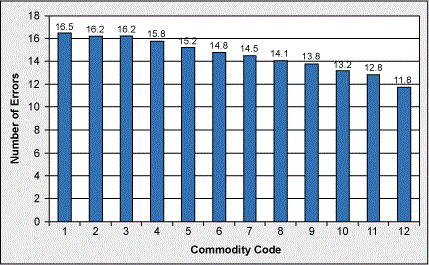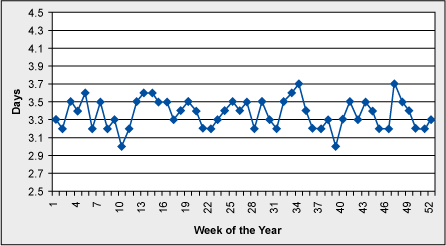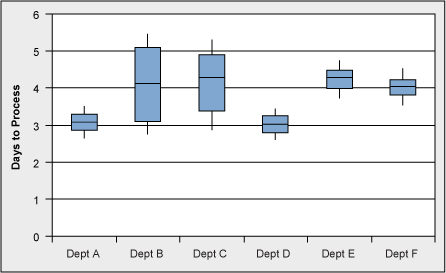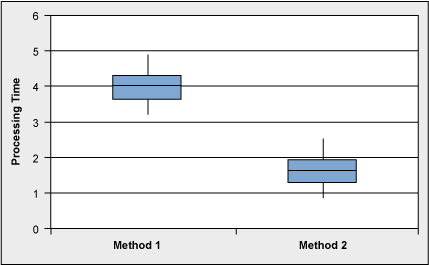
Searching for lost gold in the transactional environments that are major components of all organizations is a Six Sigma imperative. A number of ways are available for successfully mining transactional processes, thereby reaping significant savings.
Transactional- or service-focused Black Belts and Green Belts address problems which center on the elimination of process chaos. Transactional chaos results in long wait times, missed deadlines and reactionary, expensive firefighting. Finding the culprit of lost time and money is the objective.
Most metrics in a service organization are based on averages (average wait time, average audit days, mean claims processed). This view can lead to a false sense of security that the process is working properly when, in actuality, there is significant rework and variation causing chaos to those involved in the process. To the point: If a person has one hand in boiling water and one hand in a block of ice, on average, their hand temperature is comfortable. Extreme variation in process time can be more devastating than a consistently lengthy process.
If time equals money, then time variation equals gold. Finding the root cause or causes that drive process variation is finding Six Sigma gold. For example, if order-to-delivery time which varies from between two and eight days can be improved to a consistent four days, every link in the supply chain can reduce their safety stock, advise their customers correctly of the arrival time, plan their staffing, reduce expensive expediting and focus more on core tasks.
Cycle of Measurement and Analysis
What is the best way to go about finding and mining lost gold? Within the DMAIC (Define, Measure, Analyze, Improve, Control) methodology, there is a repetitive cycle of measurement and analysis. This is a productive cycle, as it helps identify the areas that could be causing a problem and eliminates others that do not correlate with the failure. Using the following steps to mine for the culprit(s) has proven effective:
- Hypothesize
- Graph and test
- Reject or select
- Repeat or complete
Hypothesize – Usually it is easy to get people who are involved in the process to hypothesize why there is so much variation. To capture all these insights, a cause-and-effect diagram – affectionately referred to as a fishbone diagram – can be used to identify and categorize as many potential causes as possible. In subsequent reviews, consensus should be reached on the probable causes. If casual identification is difficult, the potential causes should be weighed for the following factors: potential (likelihood of it happening), impact (severity if it does happen) and frequency (how often it could happen). These numbers multiplied together will help prioritize what to check first.
Graph and Test –These potential root causes (hypotheses) need to be investigated to determine if they are legitimate causes. The first step is to graph data collected around the potential cause and look for something to jump off the page. Since newly trained Green Belts and Black Belts are overwhelmed with a lot of new information and new tools, a quick reference guide like the one below helps in choosing the right tool.
|
Theory |
Recommended Tool |
What to Look for |
| Time-related cause (seasonality) |
Run Chart |
Trends (up, down, patterns, spikes) |
| One or more categories or departments are causing the failure |
Pareto Chart |
80/20 Rule (one or two major drivers) |
| One or more of the process steps are causing the failure |
Box Plot |
Tall boxes (indicates high variation) High boxes (indicates high mean) |
| The interaction of two inputs is causing the failure |
Scatter Plot |
Grouping around a 45-degree angle |
Reject or Select – Using these graphical tools gives the first indication of whether a potential cause should be eliminated from consideration. In addition to these visual determinations, if a finding is questionable, there are mathematical tests such as a two-sample t-test that will determine if the identified cause is statistically different enough from other possibilities. With these tools, a project team will begin to reject some of its theories and select others to investigate further.
Repeat or Complete – As necessary, a project team will repeat the process until the investigation is complete and the deeply buried cause is found.
An Example of Successful Mining
Below is a real-life example of this measure-analyze investigation loop. It is based on investigating the potential causes of large variation in processing time: 1) commodity difference, 2) seasonality and 3) departmentdifference.
|
Theory |
Tool |
Result |
| Some commodities take longer (Figure 1) |
Pareto |
No difference between commodities (fairly flat chart) – reject hypothesis |
| Certain times of the year there are more claims to process, increasing time (Figure 2) |
Run |
No indication that busy time of year is when processing takes long (flat run chart) – reject hypothesis |
| Some departments have more variation than others (Figure 3) |
Box |
Two of six departments had much larger variation (taller boxes) – initially accept, statistically test, dig deeper |
| Difference between two methods of processing within the department (Figure 4) |
Box |
One of two methods has a much higher mean (box higher on the left axis) – initially accept, statistically test, dig deeper |
| When Method 1 (automated database) fails to import all open claims the first time, claims remain open until the next batch |
Two-Sample |
Statistically significant difference between claims imported and claims remaining for next batch – accept, found gold! |




The automated claims process was reprogrammed to capture all open claims. This improved the average processing time and significantly reduced the variation of all claims processed across departments. This reduced phone inquiries, the need for expediting, manual overrides and a lot of frustration.
Conclusion: Guidance, Practice and Tenacity
Fluid use of the available Six Sigma tools does not have to be difficult. It just takes a good guide, practice and tenacity. Going after process time variability is like going after a huge gold mine that everyone else has been ignoring. The results will be eliminating fluctuations that were previously deemed “normal business,” identifying opportunities to reduce rework, improving internal and external customer satisfaction, and preparing the organization to look at other areas of opportunity.